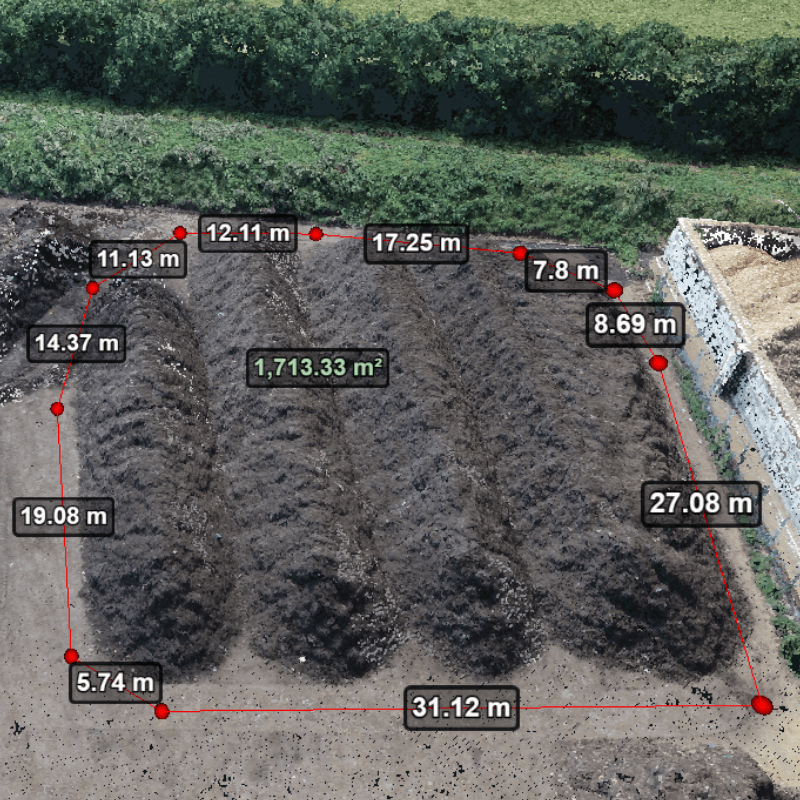
News
Drones For Stockpile Measurements
Drones enable quicker, safer and easier stockpile management, compared to traditional methods. This in-depth guide explains how drones can be used to collect accurate photogrammetry and LiDAR data and how processing software can be used to ... Read More

Drones have become a key tool for stockpile measurements and volumetric analysis;
Balfour Beatty Case Study: Handheld methods = one day to manually collect the stockpile data and process it; Drones = 2 hours and 15 minutes to autonomously collect the stockpile data and process it;
Terra Drone Europe Case Study: DJI Phantom 4 RTK drone requires fewer GCPs, while still achieving 3cm accuracies during stockpile data collection;
Drone software uses the drone data to build visual maps and models for analysis, calculations and team-wide collaboration.
Whether you work in construction, mining or aggregates, stockpile management is a crucial operation on any jobsite.
But traditionally, this process has involved manual data collection, resulting in time-consuming, costly, and potentially dangerous ground-based surveys.
Thankfully, a new solution has emerged to eliminate these issues: Volumetric Drone Surveys.
Drones automate this process, making it safer, easier and quicker to obtain highly-accurate data. The data from these aerial surveys is processed to build visual 2D maps and 3D models for insights, analysis and calculations.

As Craig Matthews, of Balfour Beatty says: "It would take a surveyor, using traditional handheld equipment, about a day to measure the stockpiles and process the data. But using the drone, we can fly over the compound in 15 minutes and process the model in about two hours."
This blog will explore the benefits of using drones for stockpile management and the best workflows for this operation.
Drones For Stockpile Measurements: Workflow
If you're new to using drones for stockpile management, the process might seem complicated or daunting. But in truth, drones and drone mapping software simplify matters - providing rich data in the process.
Using heliguy™ client SUEZ as a case in point, here's an overview of the drones for stockpile management workflow.
1 - Fly: Automate your drone flight and capture imagery to turn into maps and 3D models.
SUEZ used DJI's low-altitude mapping solution, the Phantom 4 RTK, to collect their stockpile data. The DJI GS RTK app - as well as drone mapping software such as DJI Terra or Esri Site Scan - can be used to pre-plan flights on the P4 RTK to automate data collection.

2 - Process The Data: Input the data into a drone mapping software platform, such as DJI Terra or Esri Site Scan, to create high-resolution 2D maps and 3D models.
In this case, SUEZ used the drone data and Esri Site Scan to create an orthomosaic of the whole site, including stockpiles. The stockpile which will be measured in step three (below) is highlighted by the orange circle.
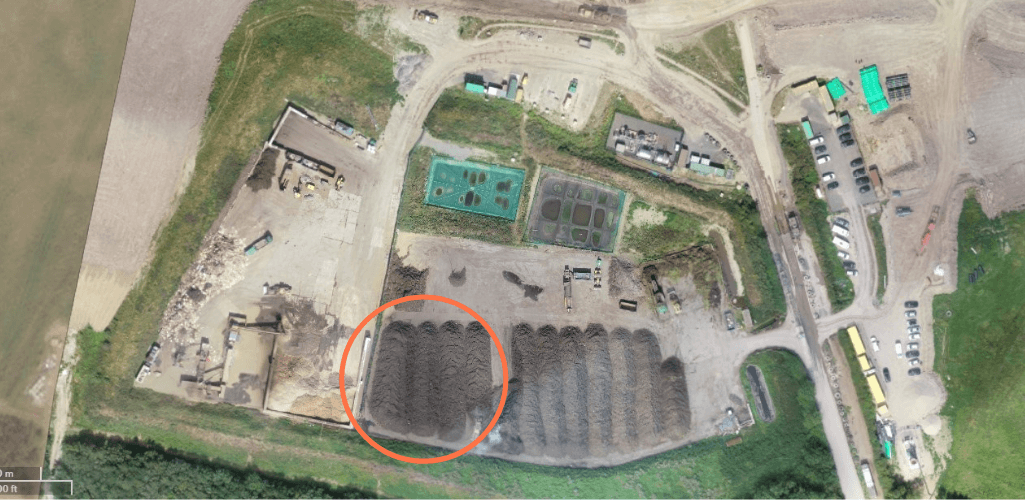
The map - built by converting imagery captured during a single 15 minute drone flight - provides a real-time view of the entire site, which is useful for a range of insights over and above stockpile calculations.
3 - Analyse: The crux of the issue - conducting the stockpile measurements.
Taking the stockpile highlighted above, the first step is to draw around its boundary (left image).
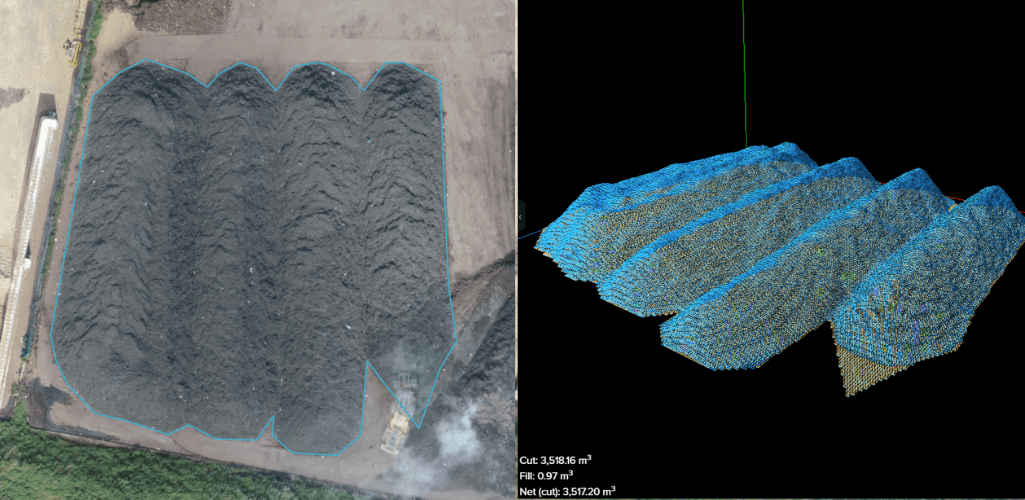
You can then convert the orthomosaic into a 3D mesh (right-hand graphic) to better visualise the stockpile.
In just a few clicks, SUEZ obtained the following information:
Cut: 3,518.16 m3
Fill: 0.97m3
Net Volume (cut): 3,517.20m3
Area: 1,531.57 m²
In this example, the net volume displays 'cut', meaning the tool detected an excess of volume over the base, ie a stockpile.
If the net volume displays fill, it means that the tool detects a negative volume (or the absence of material), indicating a trench.
Crucially, this information can be quickly and easily shared with stakeholders or other team members.
Deeper Stockpile Insights With Drones
Calculating stockpiles enables site managers to measure progress and keep stock of material inventory.
The above example demonstrates how drones and mapping software can give information about the volume of a stockpile - but the insights run far deeper.
Continuing using Esri Site Scan as an example, one of the biggest advantages is being able to conduct comparisons, analysing how a stockpile has changed over time and working out how much material has been added and removed.
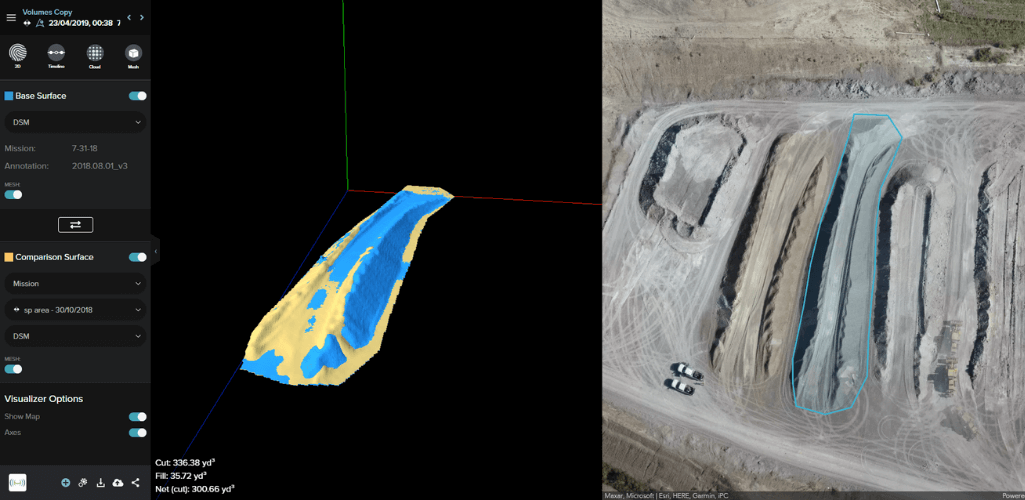
The above image shows the difference in the size of the stockpile between October 2018 and April 2019. In this case, the net volume has reduced from 1,054.64 yd3 to 870.60 yd3. The blue (base surface) and yellow (comparison surface) provide a striking visual representation of how the stockpile has changed.
In this example, there is a six-month difference between the two flights, but drones enable regular on-site data collection. Imagine how useful this digitised comparison data would be on a more regular basis, throughout the lifecycle of the project.
As well as numerical data, drone software also provides rich visual insights which can streamline decision-making.
For instance, this graphic shows parts of the stockpiles which exceed a specified height (set by heliguy™ as an example) - shown below in red.
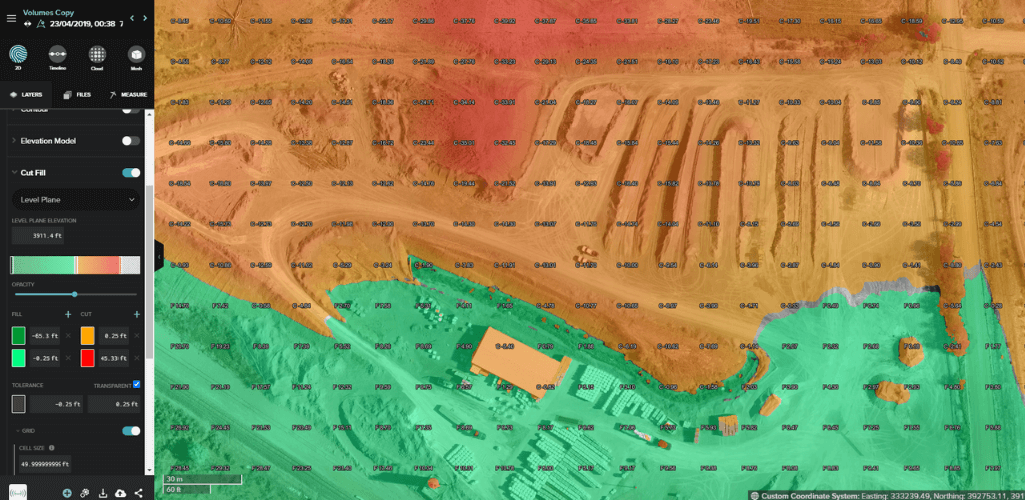
This is a useful visual guide to help site managers position material in the most suitable places.
Volume calculations have been mentioned previously, but the below examples reiterate the streamlined process of obtaining other stockpile measurements with drone data.
The first picture shows two key pieces of information: The length of the stockpile (41.46m) and the change in elevation across the stockpile (4.09m from base to middle, and an average of 0.59m across the entire stockpile).
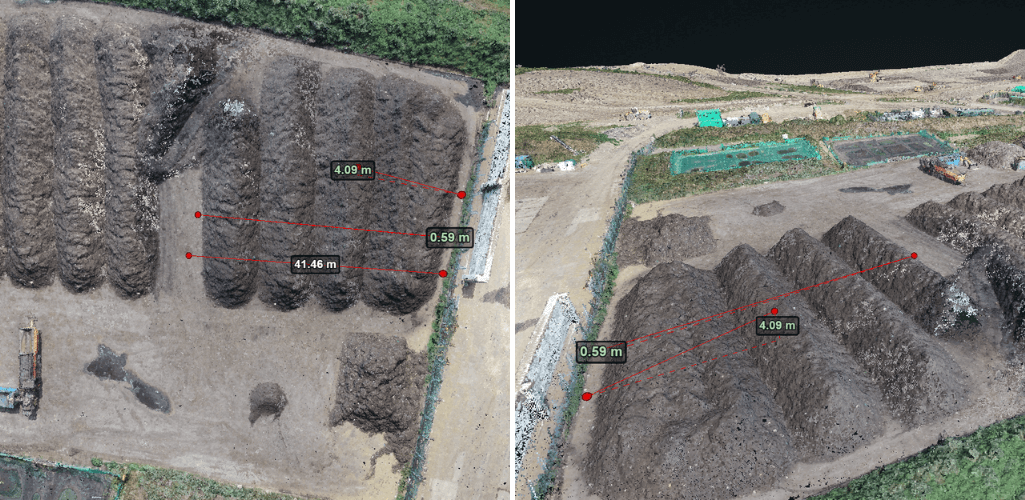
The second image shows how the software can be used to calculate the area of the stockpile: In this case, 1,713.33 m².
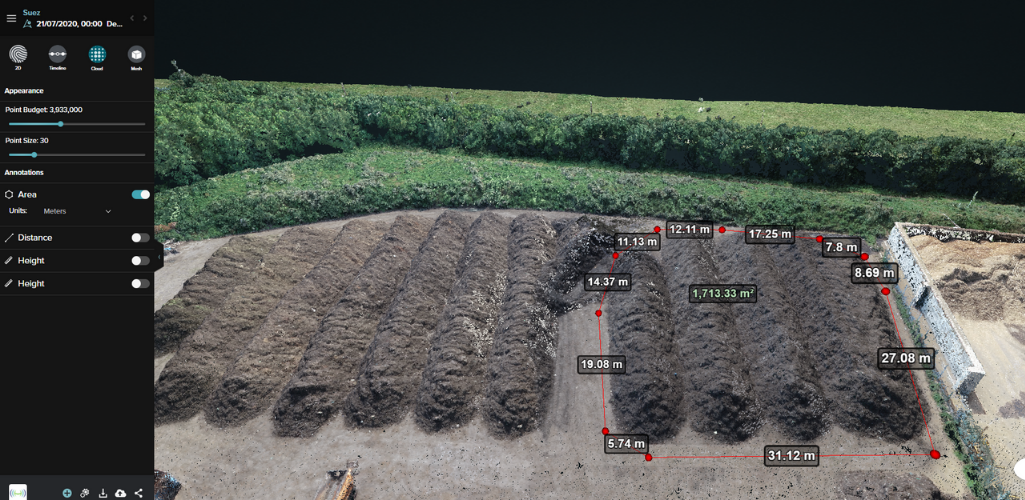
In both examples, these measurements were obtained with a few clicks of the mouse, by simply drawing around or across the stockpile(s).
Using a point cloud, this data can also be viewed in conjunction with a cross-section report, helping to demonstrate the material's height profile. Each part of the cross-section can be clicked to provide specific height information.

Stockpiles aren't always a nice simple shape or positioned on flat ground, so drone processing software enables users to compensate for that.
DJI Terra, for instance, facilitates the choice between two base plane options: The Mean Plane and the Lowest Plane.
Mean Plane: A plane (possibly inclined) fitted with multiple measurement points as the reference plane.
Lowest Point: Use the plane of the lowest elevation point among the measurement points as the base plane. This is ideal for calculating volumes of stockpiles on flat ground in bins, or where there are neighbouring piles up against each other.
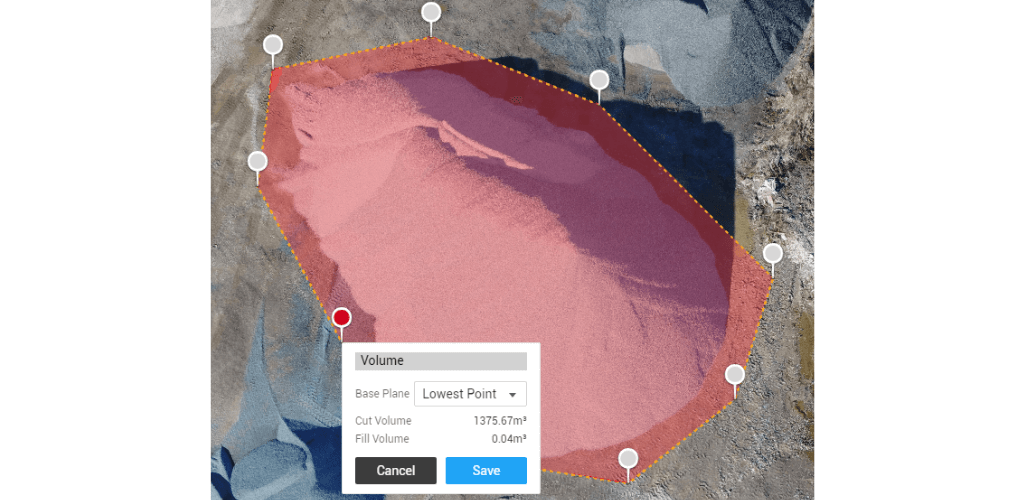
The above examples use drone photogrammetry to build maps and models to obtain the data.
However, drone LiDAR can also be utilised to conduct stockpile measurements, using processing software such as Terrasolid.
This platform is used in conjunction with DJI Terra and engineered to help surveyors process high-quality point clouds from DJI L1 drone data.
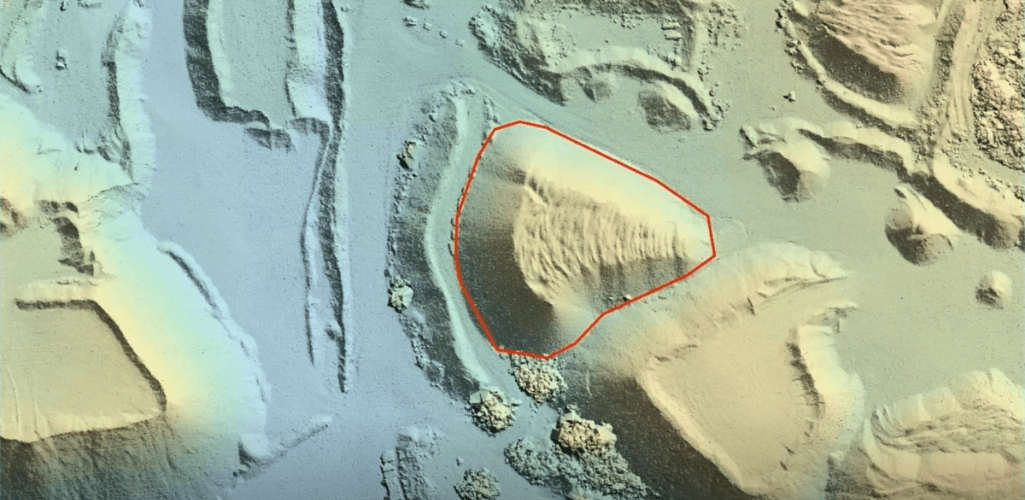
It enables you to process the point cloud data, generate a DEM (Digital Elevation Model) and calculate corresponding volumes and masses.
By comparing surface models captured at different points of time, the erosion and accumulation (cut and fill) of material can be easily monitored and documented - especially useful for stockpile measurements.
Drones vs Traditional Stockpile Measuring Techniques
Traditional methods of collecting stockpile data have their disadvantages and limitations.
Manual missions can take days or even weeks to collect data as they often involve methods such as a walking wheel, a bucket, or taking laser measurements at precise locations.
In some cases, companies will simply “eyeball” a stockpile - an approach riddled with inaccuracies that should be avoided at all costs.
Manual data-collection methods are conducted in hard-to-reach locations, where personnel can be exposed to hazardous materials or situations.
And traditional GPS methods only provide computer generated surfaces of a particular stockpile, instead of rendering detailed and site-wide maps and models.
In contrast, drones can be deployed quickly in hard-to-reach areas to collect high-resolution aerial images for point clouds and precise 3D models - such as this one in DJI Terra.
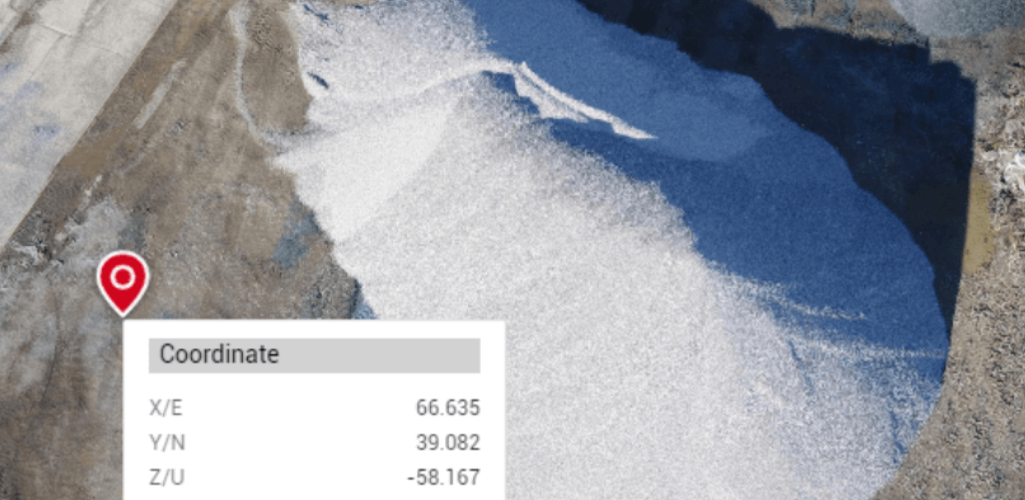
Unlike traditional forms of stockpile analysis - such as laser surveying - drones capture a vast quantity of geo-tagged data points from multiple angles and with high degrees of overlap.
This enables the creation of very dense point clouds, helping to build highly-accurate maps and models for analysis and calculation.
And as drones use either photogrammetry or LiDAR, they are especially useful for stockpiles with odd shapes.
As a bonus, drones can be flown as regularly as needed to generate accurate and up-to-date maps and models on demand, and covering large sites in much less time.
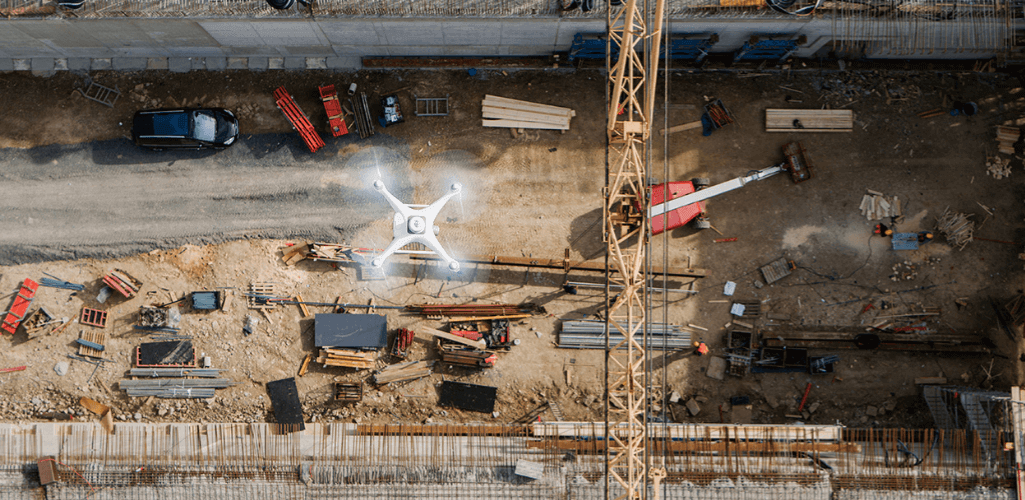
In turn, this dramatically reduces surveying costs. For instance, using drone mapping software DroneDeploy, Martin Remote Sensing reduced its stockpile survey costs by 50%
Drones, such as the DJI Phantom 4 RTK and M300 RTK-P1 combination, also require fewer ground control points (GCPs) to be put out, saving time and improving safety. In fact, the M300 RTK-P1 can obtain accurate surveying data without requiring GCPs.
Meanwhile, an in-depth test by Terra Drone Europe revealed that the P4 RTK obtained 3cm accuracies without any GCPs. Despite this, Terra Drone Europe recommended using at least four GCPs in cases where higher accuracies are required - but this is still a reduction in GCPs compared to ground-based, manual data-collection methods. Read the full report.
The icing on the cake is that drones make it safer for personnel to collect stockpile quantities, keeping staff away from danger areas.
Enhanced Accuracy: Why It Matters
Measuring stockpiles is a crucial application for the AEC industry.
Needless to say, the more accurate the data, the better the results - providing a more complete oversight of your stockpile inventory.
This enables you to answer questions such as how much is sitting in the stockyard right now? How much is going in the crusher or mill? What do you still need to extract?
Such information enables the following:
Better Supply Chain Logistics: Having an accurate count of the materials you have available means you can make informed decisions about how much you need to purchase or extract. Otherwise, you run the risk of over-purchasing or underestimating the amount of material you need.
Detailed Forecasts: Using drones to measure stockpiles is cheaper and easier than using traditional surveying equipment. It is also far more accurate than “eyeballing” stockpile volumes. Drones enable more frequent surveys, putting up-to-date information in your hands to make better decisions.
Reduce Write Offs: Regular stockpile volume measurements allow you to complete work orders accurately and efficiently, ensuring your output matches your numbers - saving you money in the long run.
Best Drones For Measuring Stockpiles
DJI has a number of drone solutions to enable more efficient stockpile calculations.
M300 RTK
DJI's most powerful enterprise drone, the M300 RTK offers an efficient drone surveying solution - especially over larger sites. Read this report to see just how efficient it can be for surveying.
Its IP45 rating ensures that drone mapping missions can be completed in difficult weather conditions.
The drone can be integrated with the P1 45MP full-frame sensor for photogrammetry data, or the L1 LiDAR sensor, which supports up to three returns and real-time point cloud generation.
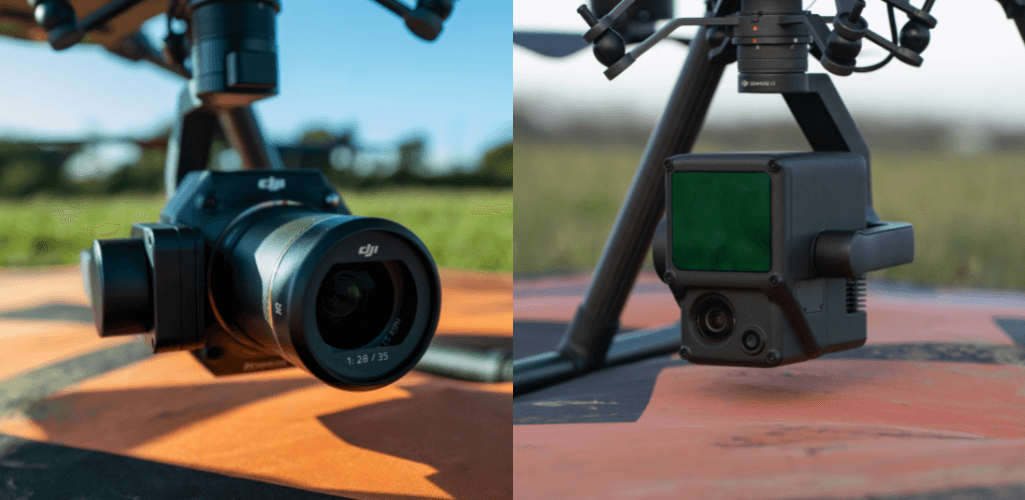
The M300 RTK can also be integrated with the GeoSLAM ZEB Horizon LiDAR sensor for rapid mobile scanning. This sensor can also be handheld. Find out how the ZEB Horizon can be used for stockpile measurements in our in-depth blog.
Phantom 4 RTK
The DJI Phantom 4 RTK is a dedicated, all-in-one drone mapping solution. It is especially suited to low-altitude or smaller-area surveying, and is an ideal entry-level aircraft for drone mapping.
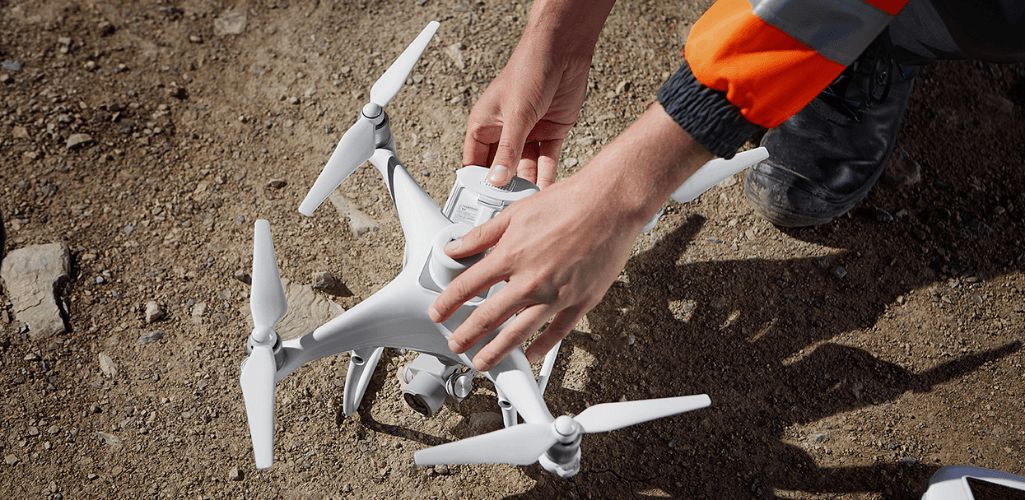
It benefits from a 20MP sensor for photogrammetry, and an in-built RTK module providing real-time, centimetre-level positioning data for improved absolute accuracy on image metadata.
Drones For Stockpile Measurements: Summary
Time-consuming, costly and potentially dangerous stockpile management is becoming a thing of the past, thanks to drones.
Using photogrammetry and/or LiDAR, drones enable efficient, safe, accurate and automated data collection, which is then brought to life through processing software.
In turn, this rapid data collection, coupled with the rich insights that can be gleaned from the software, and quickly shared, drives decision-making and increases ROI.
Contact heliguy™ by phone or email to discuss how we can help you start or scale your AEC drone programme today.
Facilitating end-to-end workflows, the heliguy™ one-stop-shop industry approach includes proof of concept, consultancy, hardware supply and streamlined/international logistics.
heliguy™ also delivers UK CAA-approved drone training, as well as industry-specific closed courses, including specialist GIS training utilising our in-house surveying professionals. On top of this, the heliguy™ Drone Assistive Programme empowers in-house drone teams by delivering hands-on, on-site, real-world training to bolster pilot competence.
**heliguy™ supports the drone programmes of GIS and AEC clients such as Komatsu, Balfour Beatty and Laing O’Rourke.**
